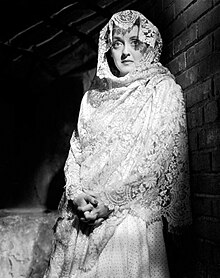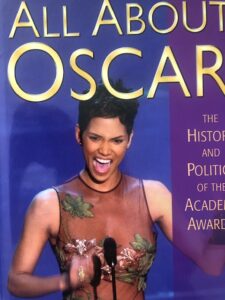William Wyler’s The Letter, a remake of the 1929 film based on Somerset Maugham’s tale of an adulteress wife who shoots her lover in a jealous rage, was marked by a distinctive visual style, and was nominated for the Best Picture and other significant awards.
Grade: A- (**** out of *****)
| The Letter | |
|---|---|

Theatrical release poster
|
|
The wonderfully juicy role of Leslie Crosbie had been played on stage by Katharine Cornell and by Jeanne Eagles in the first film version. It was the perfect vehicle for Davis, then at the prime of her career, having won a second Oscar for the 1938 Jezebel.
My Oscar Book
Both Jean Eagles and Bette Davis were nominated for the Best Actress Oscar, though neither had won.
The screenplay by Howard E. Koch is based on the 1927 play of the same name by Maugham derived from his own short story. The play was first filmed in 1929, by director Jean de Limur.
The story was inspired by real-life scandal involving the Eurasian wife of the headmaster of a school in Kuala Lumpur convicted in a murder trial after shooting dead a male friend in April 1911. She was pardoned by the local sultan after public furor.
One night, while her husband is away on an inspection tour of the Malayan rubber plantation he manages, Leslie Crosbie (Davis) shoots and kills Geoffrey Hammond (David Newell), an intimate “family” friend. She later claims that Hammond tried to attack her. Leslie’s husband implicitly believes her rational account of the murder, but serious doubts are raised by Howard Joyce (James Stephenson), the attorney who represents her.
While Leslie is in jail, awaiting release on bail, a messenger brings word that Hammond’s Eurasian widow (Gale Sondergaard) has a letter written by Leslie in which she asks Hammond to visit her on the night he was murdered. Leslie confirms having written the letter, and confesses to Joyce that Hammond was indeed her lover.
Jeopardizing his career, Joyce agrees to help Leslie obtain the letter for a fee of $100,000 that Mrs. Hammond demands. He also lessens the letter’s contents and significance to Robert, who instructs him to buy it. However, before handing the letter, Mrs. Hammond asks that Leslie come for it herself.
Leslie’s trial is brief and her acquittal brings cheers from the spectators. Later, during a celebration party at Joyce’s home, when Robert learns that his life savings were spent to buy the letter, he demands to see it. Confronted, Leslie admits that Hammond had been her lover and that she still loves him. Though heartbroken, Robert forgives his wife.
Left alone, Leslie walks into the garden, where an Oriental boy steps from the shadows and grabs her arms. Before she can scream, Hammond’s widow shows up, flashing a dagger and stabbing Leslie to death. At the end, the police arrest the Eurasian woman and the houseboy.


In the hands of another director, Maugham’s tale could have become a turgid and lurid melodrama, but Wyler treated it with respect and taste, which resulted in a superlative feature replete of psychological and emotional tension and insinuating ambience.
Considering she plays a cold, conniving murderess, under Wyler’s nuanced helming, Davis gives a taut, slightly calculated but restrained performance
Though Davis is the film’s center, Herbert Marshall (who had played the lover in the 1929 version of the film, made by Paramount) also excelled as the long-suffering, gentle loving husband.
As the honest lawyer, who puts his career in jeopardy for a friend, James Stephenson also was excellent, often stealing scenes from his more estimable co-stars.
Wyler would cast Bette Davis again, as the conniving and greedy Regina Giddens, in Lillian Hellman’s The Little Foxes (1941), which would be nominated for 9 but, again, would not win any awards.
As noted, Wyler’s film was the second (and best) version of Maugham’s story. A third, disappointing remake, titled The Unfaithful, was made by Warner in 1947.
James Stephenson
In a peculiar turn of events, it was first Jack Warner’s idea to cast Stephenson as the lawyer against Wyler’s instincts. But when Wyler had a change of heart, Warner balked at the casting, fearing that Stephenson was not big enough name, but Wyler, living up to his stubborn reputation, insisted and Stephenson stayed, receiving his first and only Supporting Actor nomination.
My Oscar Book
Oscar Nominations: 7
Picture, produced by Hal B. Wallis
Director: William Wyler
Actress: Bette Davis
Supporting Actor: James Stephenson
Cinematography (b/w): Gaetano Gaudio
Original Score: Max Steiner
Film Editing: Warren Law
Oscar Awards: None
Oscar Context:
In 1940, Hitchcock’s Oscar winning thriller “Rebecca” competed for the top award with nine other films: Hitchcock’s own “Foreign Correspondent” (on of his lesser movies), “All This and Heaven Too,” “The Grapes of Wrath,” “The Great Dictator,” “Kitty Foyle,” “The Letter,” “The Long Voyage Home,” “Our Town,” and “The Philadelphia Story.”
Like Hitchcock, John Ford had two movies in contention: “The Grapes of Wrath,” starring Henry Fonda, and “The Long Voyage Home,” with John Wayne. The three most nominated pictures were “Rebecca,” with 10 nods, John Ford’s socially-aware class drama “The Grapes of Wrath,” and William Wyler’s melodrama, The Letter,” each with 7.
In 1940, “The Letter” lost in each and every category it was nominated. Rebecca” won the black-and-white Cinematography Oscar (by George Barnes). Ginger Rogers won Best Actress for “Kitty Foyle,” and Walter Brennan won his third Supporting Oscar in five years (a record) for Wyler’s other 1940 film, “The Westerner.”
The Best Score Oscar went to Leigh Harline, Paul J. Smith, and Ned Washington for Pinocchio, and the Editing award to Anne Bauchens for Northwest Mounted Police.
Credits:
Directed by William Wyler
Screenplay by Howard E. Koch, based on 1927 play “The Letter” by W. Somerset Maugham
Produced by Hal B. Wallis (Exec)
Cinematography Tony Gaudio
Edited by George Amy, Warren Low
Music by Max Steiner
Distributed by Warner Bros.
Release date: Nov 22, 1940 (NYC)
Running time: 95 minutes




